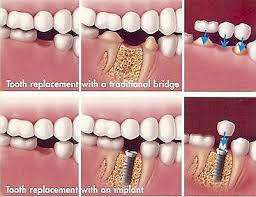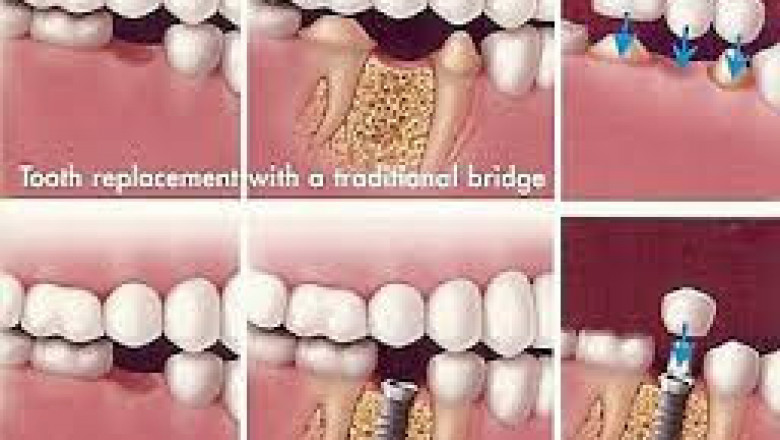views
Understanding the Need for Tooth Replacement
Tooth loss is more common than many people think, and whether it's due to injury, decay, or gum disease, it can significantly impact your life. Missing teeth can make it harder to chew and speak properly, and they can affect your self-confidence. Thankfully, modern dentistry offers reliable options to restore your smile and function. Two of the most recommended solutions are dental bridges and dental implants. Understanding the differences between them can help you make the best decision for your oral health and lifestyle.
What Is a Dental Bridge?
A dental bridge is a prosthetic device used to fill the space left by one or more missing teeth. It typically involves placing crowns on the teeth adjacent to the gap, which then anchor a false tooth (or teeth) in between. Bridges are custom-made to match your existing teeth in shape and color, offering a natural appearance.
The procedure usually requires two visits. During the first, the adjacent teeth are reshaped and impressions are taken. A temporary bridge is often placed while the permanent one is crafted in a dental lab. Once ready, your dentist will cement the permanent bridge in place, ensuring a proper fit and bite alignment.
What Is a Dental Implant?
A dental implant replaces a missing tooth by surgically placing a titanium post into the jawbone. This post acts as an artificial tooth root, which then supports a crown that looks and feels like a natural tooth. Unlike bridges, implants do not rely on neighboring teeth for support, which can preserve the integrity of your remaining natural teeth.
The process of getting a dental implant takes longer than a bridge and often involves multiple stages. After placing the implant, there’s a healing period that allows the post to fuse with the bone through a process called osseointegration. Once healed, a custom crown is attached to the implant for a permanent solution.
Comparing Treatment Time and Process
If you're looking for a quicker solution, a dental bridge may be more appealing. Most bridges can be completed within a few weeks, with two or three dental appointments. Dental implants, on the other hand, take several months due to the surgical healing time.
However, the extra time for implants comes with long-term benefits, including bone preservation and a more stable, natural feel. Patients with sufficient jawbone density and good oral health are typically better candidates for implants. In contrast, those who have experienced bone loss may require bone grafting before implant placement, which can further extend the timeline.
Durability and Longevity
Both dental bridges and implants are designed to be durable, but implants generally last longer. With proper care, an implant can last 20 years or more—often a lifetime. Dental bridges typically have a lifespan of 10 to 15 years, after which they may need to be replaced due to wear or damage to the supporting teeth.
It's also important to note that bridges can place additional stress on the adjacent teeth. If these supporting teeth are already weakened or have large fillings, they may be more susceptible to problems over time.
Aesthetic and Functional Results
Both options offer excellent aesthetic results when performed by an experienced dentist. Implants tend to provide the most natural look and feel because they mimic the entire structure of a natural tooth, from root to crown. They also help preserve facial structure by stimulating the jawbone, which can prevent the sunken appearance often associated with tooth loss.
Bridges also offer a natural appearance and can be a great option for replacing front teeth. They improve chewing ability and can prevent neighboring teeth from shifting out of place, which helps maintain alignment and overall oral health.
Cost Considerations
Cost is a significant factor for many patients. In general, dental bridges are less expensive upfront than implants. However, when you consider the long-term value and durability of implants, they may offer a better return on investment. Additionally, bridges may require more maintenance or replacement over time, which could lead to higher costs in the long run.
Insurance coverage may also vary. Some dental plans cover bridges more readily than implants, although this is changing as implants become more widely accepted and recommended in dentistry.
Maintenance and Oral Hygiene
Dental bridges require meticulous cleaning to avoid plaque buildup around the supporting teeth. Special flossing tools may be needed to clean beneath the pontic (the false tooth), and routine checkups are essential to monitor the health of the abutment teeth.
Implants, on the other hand, are easier to maintain because they mimic natural teeth. Regular brushing, flossing, and dental visits are typically all that’s required. Since they don't affect neighboring teeth, implants also reduce the risk of decay in surrounding areas.
Making the Right Choice
Choosing between a dental bridge and a dental implant depends on several factors, including your oral health, bone density, personal preferences, budget, and how quickly you need a solution. A consultation with your dentist is the best way to determine the most suitable option based on your unique situation.
Your dentist will examine your mouth, take x-rays, and discuss your goals and concerns before making a recommendation. It’s essential to weigh both the short-term and long-term benefits, as well as the level of maintenance you're comfortable with.
Conclusion
When it comes to choosing between a dental bridge and an implant, there is no one-size-fits-all answer. Both have their advantages, and the best option for you depends on your specific needs and goals. By understanding the differences, you can make an informed decision that restores your smile and confidence for years to come. Consulting with a trusted dental professional will ensure you receive care tailored to your health, lifestyle, and budget.























Comments
0 comment